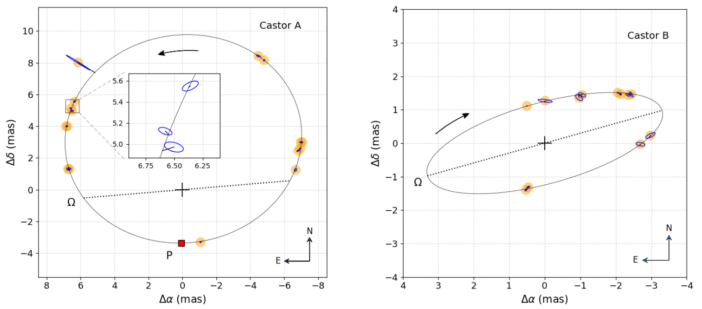Editor’s Note: Astrobites is a graduate-student-run organization that digests astrophysical literature for undergraduate students. As part of the partnership between the AAS and astrobites, we occasionally repost astrobites content here at AAS Nova. We hope you enjoy this post from astrobites; the original can be viewed at astrobites.org.
Title: The Orbits and Dynamical Masses of the Castor System
Authors: Guillermo Torres et al.
First Author’s Institution: Center for Astrophysics | Harvard & Smithsonian
Status: Published in ApJ
In today’s bite, astronomers study the orbits of a sextuple system — an absurdly complex arrangement of six stars in orbit around one another — in order to measure the stars’ masses once and for all. To do so, the team ended up using nearly 200 years’ worth of data!
Stellar Ballrooms: Laboratories for Weighing Stars
Stellar multiples — binaries, triple stars, and even higher-order configurations of four, five, or, in today’s case, six stars — have a lot to teach us. By measuring stars’ orbits and applying Kepler’s laws, astronomers can determine the masses of stars (and other bodies, like planets and black holes). These are extremely important measurements to make, because other measurements of stars (and planets, and other things) can only be used to infer an object’s mass by making an assumption based on the kinds of light it emits. A lot of our understanding of stars is thanks to these “dynamical” mass measurements from binary stars.
Stellar multiples are also interesting in their own right — how they orbit and in what way tells astronomers a lot about how star formation occurs and what the likely and unlikely outcomes of star formation are.
Castor: Six Stars in a Trench Coat
Castor holds the distinction of being the first true physical binary to be recognized as such (Herschel 1803), based on changes in the direction of the line joining the two stars observed over a few decades. This has been regarded by some as the first empirical evidence that Newton’s laws of gravitation apply beyond the solar system.
Torres et al. 2022, §1, ¶1
Castor is the second brightest star in the constellation Gemini, next only to Pollux. With the advent of telescopes, astronomers in the 18th and 19th centuries discovered that Castor was actually a binary, Castor AB. Then, it became a triple star system when YY Geminorum (Castor C) was found to orbit Castor AB. Trouble really started brewing when, in 1896, Castor B was measured twice with a spectrograph, the measurements taken four days apart. The radial velocity of the star had changed dramatically between the two observations, and further measurements indicated the star was a spectroscopic binary. Subsequent observations of Castor A and Castor C proved them to be spectroscopic binaries as well! One star became six stars, all dancing about each other (Figure 1).

Figure 1: An artist’s impression of the Castor system, showing each binary pair and their orbits around each other. The system is a hierarchical triple in which each component is a spectroscopic binary. [Adapted from NASA/JPL]
Interferometry to the Rescue!
Today’s authors took new observations of Castor A and Castor B using the Center for High Angular Resolution Astronomy (CHARA) array, a long-baseline optical interferometer located on Mt. Wilson in California. With the resolving power of interferometry, the authors were able to directly measure the position of each spectroscopic binary pair over time, mapping out each orbit in all three dimensions for the first time (Figure 2). Combined with archival astrometry and radial velocity measurements from as far back as 1778, the authors were able to fit each orbital path and determine the dynamical masses for all of the components in the system.

Figure 2: The interferometric measurements of the positions of Castor Ab and Bb around Castor Aa and Ba respectively, and the best-fit orbit to the interferometric and radial velocity measurements. [Adapted from Torres et al. 2022]
Original astrobite edited by Pratik Gandhi.
About the author, William Balmer:
William Balmer (they/them) is a PhD student at JHU/STScI studying the formation, evolution, and composition of giant planets, brown dwarfs, and very low mass stars. They enjoy reading, tabletop games, cycling, and astrophotography.
